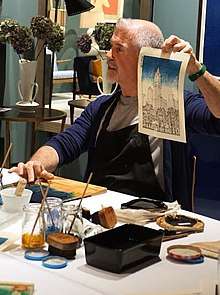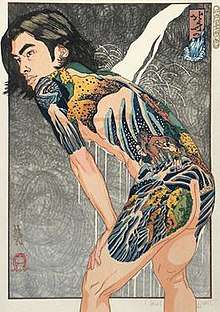Paul Binnie
| Paul Binnie | |
|---|---|
 Binnie in 2017 | |
| Born |
Paul James Binnie May 27, 1967 Airthrey Castle, Scotland |
| Residence | London |
| Nationality | British |
| Education | Edinburgh University and Edinburgh College of Art |
| Known for | Japanese woodblock printing, painting, figure drawing |
Paul Binnie (born May 27, 1967) is a Scottish artist working in the Japanese tradition of woodblock printing. His work is reflective of the shin-hanga artists of the early to mid-20th century, employing subjects such as landscapes, tattoos, and bijin.
Biography
Binnie was born in Airthrey Castle, Scotland in 1967 and studied art history at Edinburgh University and painting and etching at Edinburgh College of Art from 1985 to 1990. After taking his Master's degree (honours) in 1990 he moved to Paris until his interest in Japanese ukiyo-e prints took him to Japan in 1993. There he studied woodblock printmaking as an apprentice to Seki Kenji, master printer of Doi publisher.[1]
While in Japan, Binnie began experimenting with kappazuri (stencil printing). His first stencil prints were depictions of tattooed figures, followed by yakusha-e (kabuki actor prints). By late 1995, Binnie had left Seki’s studio to concentrate on his own work, primarily focusing on actor prints, a genre which he had begun to collect.[2] His interest increased in actor prints by shin-hanga artists such as Natori Shunsen and Masamitsu Ota, and he also began to collect fukeiga (landscape prints) by artists such as Hasui Kawase and Hiroshi Yoshida.[3][4]

In 1998, Binnie moved to London and set up his own studio, where he expanded his subjects to include cloud studies, landscapes, and bijin (beautiful women).[6] While his actor prints were largely concerned with capturing an actor's expression in a given moment, his landscape and bijin prints often incorporated an historical reference, usually to well-known Japanese prints or paintings. His Shiki (Four Seasons) series, for example, referenced prints of shin-hanga artists such as Goyō Hashiguchi and Shinsui Itō. [7]

In 2004, Binnie returned to depicting tattooed figures, both male and female, in the series, A Hundred Shades of Ink of Edo in which he applied designs from ukiyo-e artists such as Hokusai and Hiroshige to nude figures. Each of the ten prints in the series was based on the work of an individual ukiyo-e artist.[10] Soon after completion of the tenth print in 2015, the Metropolitan Museum of Art in New York purchased the complete series for its collection.[11]
Binnie continues his work on bijin-ga with the series Flowers of A Hundred Years, which began in 2012. The series of ten prints explores the "changing roles, political and social situations and lifestyles of women in Japan in the 20th century, decade by decade." [12]
Collections
Significant print collections with Binnie's work:
- Metropolitan Museum of Art
- Brooklyn Museum
- Minneapolis Institute of Art
- Toledo Museum of Art
- Rijksmuseum Rijksprintenkabinet
- Nihon no Hanga Museum, Amsterdam
- The British Museum Griffith Bequest
- Edinburgh College of Art
Notes
- ↑ Brown, Griffith & Ryo 2007, pp. 18-20.
- ↑ Brown, Griffith & Ryo 2007, pp. 21,26-27.
- ↑ Brown, Griffith & Ryo 2007, p. 28.
- ↑ Brown et al. 2013, p. 65.
- ↑ Brown, Griffith & Ryo 2007, p. 126.
- ↑ Brown, Griffith & Ryo 2007, p. 22.
- ↑ Brown et al. 2013, pp. 67-68.
- ↑ "Hokusai's Waterfalls", Scholten Japanese Art, Retrieved on September 11, 2018.
- ↑ Brown et al. 2013, pp. 68,70-71.
- ↑ Brown, Griffith & Ryo 2007, p. 31.
- ↑ "Paul Binnie | Utamaro’s Erotica", Metropolitan Museum of Art, Retrieved on September 11, 2018.
- ↑ "Paul Binnie A Frontispiece Illustration of 1900", Binnie Catalogue, Retrieved on September 11, 2018.
References
- Brown, Kendall H.; Griffith, Paul; Ryo, Akama (2007). Van den Ing, Eric, ed. A Dialogue with the Past: Paul Binnie, the First 100 Japanese Prints. Chicago: Art Media Resources. ISBN 978-1-58886-096-5.
- Brown, Kendall H.; Putney, Carolyn; Shuko, Koyama; Binnie, Paul (2013). "Chapter Four: The Legacy of Shin Hanga". Fresh Impressions: Early Modern Japanese Prints. Toledo: Toledo Museum of Art. pp. 64–73. ISBN 978-0-935172-51-5.
- "Paul Binnie Biography". Artelino. Retrieved September 11, 2018.
- Reigle, Amy, ed. (2006). Hotei Encyclopedia of Japanese Woodblock Prints. Amsterdam: Hotei Publishing. ISBN 9074822657.
External links
- Binnie Catalogue (unofficial catalogue)
- Paul Binnie at ukiyo-e.org
- Japanese Woodblock Printing with Paul Binnie on YouTube
- The Making of a Print - Paul Binnie's Red Fuji
- Paul Binnie, Making a Woodblock Print, Ichikawa Ennosuke no Kurozuka